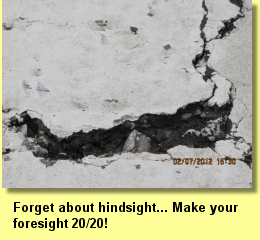 |
 |
Foresight is 20/20By Donna SpeidelIn the past decade, I've noticed 99% of our nation's airfield markings are comprised of waterborne paints. It might be the reason why I don't teach a lot about other approved materials during Airfield Marking Symposiums. I spend very little time on solvent-based paints, even less on epoxy and methracrylate (MMA), and Flint Trading takes the baton when discussing their AirMark, preformed thermoplastic. When airports call me wanting assistance with marking failures, I take it for granted they're talking about Ye Olde Waterborne Paint... I recently received a call from the other 1%.
Specifications also required the markings to be recessed in the asphalt, requiring milling a specific depth into the new surface where the markings would later be applied. The durable polyurea coating was applied and the new asphalt runway was completed. In subsequent years, my guess is just before the annual Part 139 certification inspections, the markings were "refreshed" to make the runway look pretty for the inspectors. In these cases, Ye Olde Waterborne Paint was applied repeatedly over existing markings, year after year.
It's no surprise airports are in the market for durable marking materials; you're searching for something that will last to reduce maintenance and therefore costs and closures. However, making uninformed decisions about your markings may ultimately cost you more. Hindsight is 20/20; but it pains me to make recommendations for milling and overlaying. Instead of doing what you always have done, make your Foresight 20/20 by using Sightline! |

 Seven years ago, an airport completed the construction of a new asphalt runway. The city engineer designing the project
was sold on selecting a durable polyurea (not FAA approved) material for the runway markings to be applied at a relatively thick rate
compared to traditional waterborne paint. Had the story stopped at this point, perhaps it would not have been newsworthy.
Seven years ago, an airport completed the construction of a new asphalt runway. The city engineer designing the project
was sold on selecting a durable polyurea (not FAA approved) material for the runway markings to be applied at a relatively thick rate
compared to traditional waterborne paint. Had the story stopped at this point, perhaps it would not have been newsworthy.
 Today, seven years later, the asphalt surface underneath the "durable" coating is literally coming apart, creating FOD. Runway
markings are generally 3-feet wide or more; and multiple passes of a 12-inch application creates overlap at each of the seams. Waterborne paint
alone applied repeatedly without surface preparation can cause similar adhesion problems. So, although the durable coating was intended to last
and decrease costs, it was unsuitable for an asphalt runway surface that is now scheduled for milling, overlaying, grooving, and restriping.
Today, seven years later, the asphalt surface underneath the "durable" coating is literally coming apart, creating FOD. Runway
markings are generally 3-feet wide or more; and multiple passes of a 12-inch application creates overlap at each of the seams. Waterborne paint
alone applied repeatedly without surface preparation can cause similar adhesion problems. So, although the durable coating was intended to last
and decrease costs, it was unsuitable for an asphalt runway surface that is now scheduled for milling, overlaying, grooving, and restriping.